Desilting work at Tetney Haven will help flood defences


The work, which took just over seven weeks to finish, is part of the EA’s regular repairs programme, with excess silt removed from approximately a kilometre of the Louth Canal and from around the sluice gates at Tetney Lock.
Andy Charlesworth, asset performance advisor with the Environment Agency, said: “This is a perfect example of how we aim for the most benefit for people and the environment from everything we do.
Advertisement
Hide AdAdvertisement
Hide Ad“We have a regular programme of inspection and maintenance on our flood defences, and we’re always looking for ways to achieve extra benefits at the same time.
“In this case, while we had our equipment on-site, we were able to use it in another way to give a boost to ecological conditions in the surrounding area at no extra cost.”
Silt builds up naturally at the sluice as it settles when the flowing water in the channel loses momentum at the sluice gates. Removing it means water can continue to flow easily from the canal into the Haven.
These improvements help the natural wetting and draining cycles of the soil that encourage vegetation to grow.
Advertisement
Hide AdAdvertisement
Hide AdThe plants help prevent erosion and stabilise land, which serves as a front line of flood defence by absorbing much of the force of tidal waves.
Along with other routine maintenance on the channel, removing the silt has helped to reduce flood risk to approximately 500 local homes and businesses.
At a cost of £127k, it was last de-silted 10-years-ago, and the Environment Agency’s modelling shows it is unlikely for this work to be needed again for another decade.
The work has also helped improve, preserve and extend the salt marsh’s ecology, made up of salt-tolerant plants and up to 300 species of invertebrates, half of which are unique to this environment.
Advertisement
Hide AdAdvertisement
Hide AdThese conditions, in turn, provide valuable habitat for migrating birds, some of which are endangered.
In the next financial year, the Environment Agency will spend approximately £12m on flood defence maintenance to reduce risk to local communities.